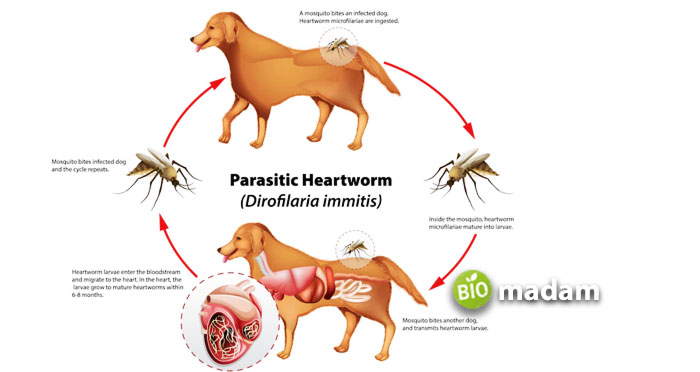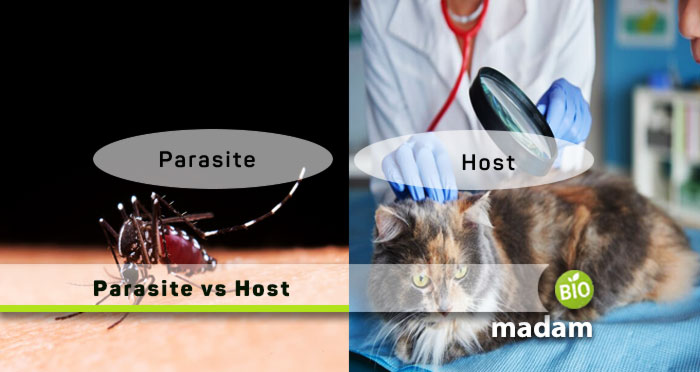Various prokaryotic and eukaryotic organisms in different communities of an ecosystem build numerous relationships with each other. Some relationships are beneficial to both, a few benefit one and do not affect the second participant, while others benefit one and harm the other. Parasitic relationships are associations among organisms in which one benefits and harms the other in return. Parasites and hosts are two different types of eukaryotic organisms that contribute to this interconnection in an ecosystems.
Let’s explain the differences between parasites and hosts for better understanding.
Comparison Table
| Characteristics | Parasite | Host |
| Definition | Organism living in another living being and harming it | Organism where parasite lives |
| Types | Ectoparasites, endoparasites, mesoparasites, facultative, etc. | Primary, secondary, accidental, paratenic, etc. |
| Size | Small | Large |
| Biological Organization | Less-complicated | Organ-system organization |
| Takeaway | Benefits | Harm |
| Leading Factors | Pathogenicity, adaptations, species, reproductive potential | Immunity, protective reflexes, health, lifestyle, and culture |
What are Parasites?
The word parasite comes from the Greek word ‘parasitos,’ meaning ‘one who eats at the table of another.’
Parasites are diverse groups of organisms living on other cells or organisms to obtain their macro and micronutrients and survive.
Despite being eukaryotic, parasites are not as huge as hosts. They exhibit a simpler organization system than their hosts.
Various arthropod types, nematodes, flatworms, mollusks, and annelids are common parasitic groups feeding on other animals. Sometimes, plants may also act as parasites for other plants. Furthermore, fungi, mold, bacteria, viruses, and protozoa can act as parasites, causing diseases or infections in their hosts.
Parasites do not typically kill other organisms, unlike predators. However, their presence in the host’s body may eventually lead to its death.

Types of Parasites
Parasites are categorized into multiple types depending on different factors. One of the most common classifications is into ectoparasites, endoparasites, and mesoparasites.
- Ectoparasites reside on the surface of an organism’s body, like fleas and ticks in cat fur.
- Endoparasites live in the body of the organisms such as hookworms in the small intestine of humans.
- Mesoparasites are partly embedded in the host’s body, forming an anchor with their anterior end. They are typically present in external openings.
Besides the classification on the basis of the location of the parasites, researchers also categorize them according to their living period in the host and nutrition dependency.
Permanent Parasites
Permanent parasites spend the complete or a major part of their life in the hosts’ body.
Temporary Parasites
Temporary parasites only visit their host organisms for a short period.
Obligatory Parasites
Obligatory parasites are completely dependent on their host for food and shelter; they cannot survive without the host.
Facultative Parasites
Facultative parasites do not rely on the host completely for survival and may live without acting as parasites. However, they take advantage of parasitic opportunities.
What are Hosts?
As the name indicates, hosts provide space for parasites to live and reproduce.
It refers to an organism in a biome or an ecosystem that acts as a shelter and provides nutrition to the parasitic organism. Normally, hosts are larger in size than parasites and comprise humans, plants, animals, or fungi.
Hosts are generally primary and intermediate. The primary host allows the parasite to take nutrition, grow, and reproduce. Alternatively, the secondary host only keeps the parasite temporarily for the transition period.
The most significant detail about a host-parasite relationship is the harm the parasite produces to the host. Parasites do not only live in or on the host’s body to obtain nutrients but also incur damage to the host. The utilization of the host’s nutrients by the parasite or excreted metabolites may sometimes lead to the host’s death.
The course of the parasitic relationship between the host and the parasite in different types of ecologies depends on the hosts’ nutrition, protective reflexes, types of immunity, and concomitant diseases. In the case of humans as the hosts, lifestyle, health, and culture also play a major role.

Types of Hosts
Hosts are also differentiated into different types to understand the role of parasites in food chains and food webs by affecting the host population. The categories of hosts are based on their role in the parasitic lifecycle. The types of hosts are:
Primary Host
Primary hosts are organisms a parasite requires to mature sexually, reproduce, and spread infection in their bodies. They are also known as definitive hosts. Anopheles is the primary host for Plasmodium.
Secondary Host
Secondary or intermediate hosts are not generally required for sexual maturation. Instead, they harbor the parasite for a short period in which it completes its developmental stage. Trypanosomes cause sleeping sickness in humans and use tsetse fly as their secondary host.
Paratenic Host
Paratenic hosts are also known as dumps as they do not contribute to the anatomical or physiological development of the parasite but help it survive. Freshwater shrimps are an example of paratenic hosts for rat lungworms.
Accidental Host
Accidental hosts act as developmental harbors for parasites from the third larval stage to the fifth stage but do not allow the parasite or bacteria to complete development. Thus, parasites do not cause disease in the accidental hosts. Humans act as accidental hosts for taenia.
Reservoir Host
Also known as asymptomatic hosts, reservoir hosts keep the parasite but do not show any ill effects. They do not get infected by the disease carried by the pathogen. Various components of biodiversity, including animals and humans, may act as reservoir hosts. The environment is also considered a reservoir host.
Differences Between Parasite and Host
Definition
Parasite
Parasites are organisms that obtain nutrition and shelter from another organism and cause diseases, bacterial or viral infections.
Host
A host is any organisms that the parasite selects to reside in, reproduce, and spread the disease.
Types
Parasite
The different types of parasites are ectoparasites, endoparasites, mesoparasites, permanent, temporary, facultative, and obligatory parasites.
Hosts
On the contrary, hosts are categorized as primary, secondary, accidental, paratenic, and reservoir.
Size
Parasite
Parasites are typically smaller in size compared to the hosts.
Host
Hosts are larger than the parasites that reside in or on their bodies.
Biological Organization
Parasite
They are simpler organisms with a less-complicated organizational structure.
Host
Hosts have a higher level of the organizational structure comprising tissues, organs and organ systems.
Takeaway from Relationship
Parasite
Parasites obtain nutrition and protection from the hosts and benefit from the relationship.
Host
The parasites typically infect the hosts. Thus, hosts are usually harmed in parasitic relationships.
Influential Factors
Parasite
The parasitic activity is influenced by the pathogenicity of the parasite, adaptations, species, subspecies, reproductive potential, need for nutrition, etc.
Host
The immunity, protective reflexes, nutrition, concomitant diseases, health, lifestyle, and culture act as influential factors in the host’s reaction to the parasite.
The Bottom Line
Parasites and hosts are important factors in our environmental processes. The symbiotic relationship between different hosts and parasites enables the regulation of different species. It also facilitates the survival of organisms that are dependent on others for their development and reproduction. The hosts act as development and reproduction sites for the parasite. In return, the parasite imparts harm to the host. Insects and other such pathogens, with their specified antigens, are widely known parasites. Last but not least, plants may also sometimes act as parasites for other plants.
FAQs
What is an example of parasite and host?
Malaria is the most common example of a parasitic relationship. The female mosquito Anopheles acts as the primary host for the parasite Plasmodium. It transmits the parasite to humans, which are secondary hosts.
Can the host be a parasite?
While the answer may surprise you, the host can be a parasite. Researchers believe that all organisms on Earth are part of host-parasite relationships in one way or the other. Organisms acting as hosts in one setting may be parasites in another.
Can a parasite live without a host?
Some parasites, like facultative parasites, do not require a host to survive. However, they take advantage of hosts to feed on them and spread disease.

Hello, I would like to introduce myself to you! I am Chelsea Rogers, an experienced blog writer for science articles, holding an MPhil degree. My enthusiasm to grab the best knowledge, let it relate to botany, zoology, or any other science branch. Read my articles & let me wait for your words s in the comment section.

